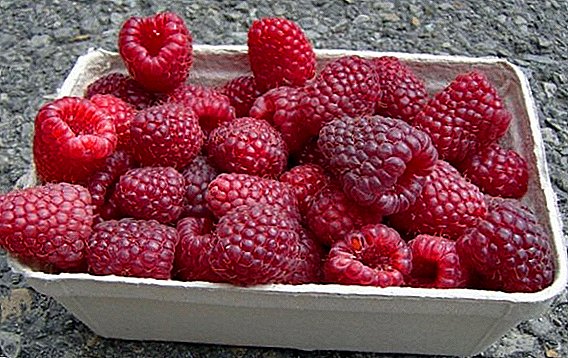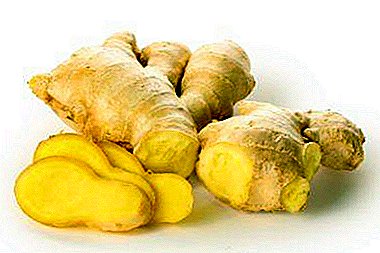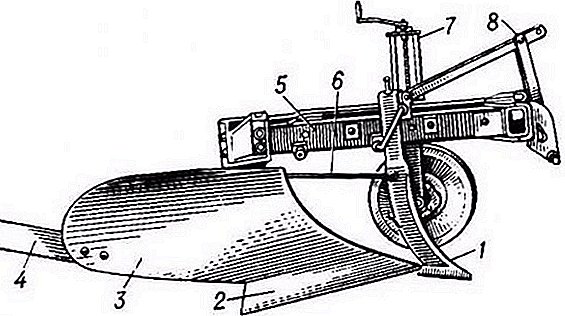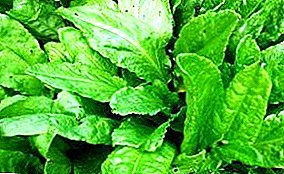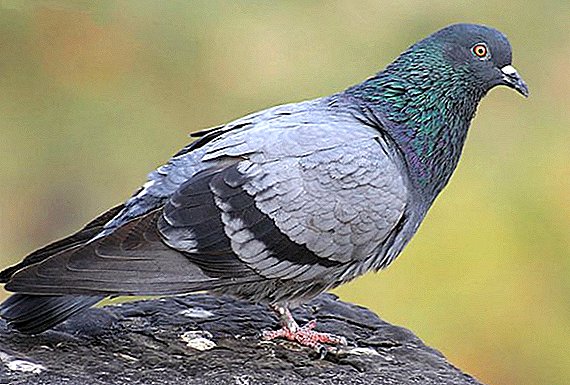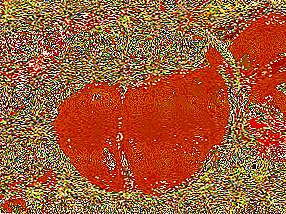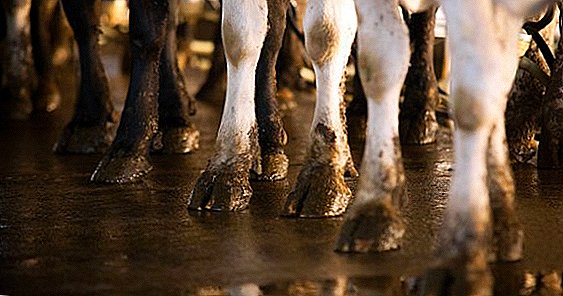 The health and cleanliness of the legs and hooves of cattle are of great importance for its efficiency and productivity, every farmer knows about this. A cow spends most of its life on its feet during walking and milking, and its hooves undergo a natural grinding process. They require careful care in order to avoid infection by various types of diseases, which we will discuss in this article.
The health and cleanliness of the legs and hooves of cattle are of great importance for its efficiency and productivity, every farmer knows about this. A cow spends most of its life on its feet during walking and milking, and its hooves undergo a natural grinding process. They require careful care in order to avoid infection by various types of diseases, which we will discuss in this article.
Diseases of hooves in cows: symptoms and treatment
First, let's look at the structure of the cow's hoof. It consists of two parts, covered with horny tissue, between which is the blade. Horny coating is constantly increasing.
In the summer period, when the animal actively moves during walking, it is ground off naturally due to contact with the ground, and in winter, when the cow is restricted in movement and is in the barn, it increases significantly. 
This can cause pain and discomfort for the animal, as well as lead to more significant consequences. In order to prevent this situation, the owner should closely monitor the condition of the limbs of cattle.
Causes of disease:
- dirt in the room and irregular cleaning;
- lack of comfortable conditions for the maintenance of the animal: little space and poor quality flooring;
- irregularity of preventive measures: cutting of the stratum corneum, cleaning the hooves should be carried out systematically.
Learn how to build a barn for cows, how to make a stall for a cow.
Symptoms:
- animal mobility, cautious movements, constant change of position, in order to relieve pain;
- improper distribution of mass on the joints;
- depressed state;
- decreased appetite;
- low productivity.
Prevention - high-quality and regular pruning and cleaning of the limbs. 
Inflammation of the basis of the skin of the hoof (pododermatitis)
Inflammatory processes that occur at the base of the hoof, have a common name - Pododermatitis. There are two types of poddermatit:
- aseptic.
- purulent.
Aseptic Pododermatitis
The reasons:
- walking a cow on hard ground;
- cattle driving on rocky terrain, concrete.
Find out what you need for free housing cows.Symptoms:
- lameness;
- pain when pressed with forceps on the hoof horn;
- fissures of the stratum corneum;
- local temperature increase, the hoof becomes hot due to the appearance of purulent clots;
- traces of hemorrhages in the form of red, yellow and purple spots when clearing the sole;
- the animal widely arranges, crosses the limbs.

Treatment:
- fresh and comfortable bedding;
- administration of Novocaine p-ra to a vein of 0.25% with a strong lesion of the disease of several hoofs;
- treatment of the injured limb with 10% iodoform, Furacilin and Rivanol;
- compresses, which must be cooling for the first few days, and then warming;
- painkillers with ointments and powders;
- hypertonic baths with antiseptic and a solution of medium salts when bandaging.
Prevention - quality control of the soil where livestock is grazed or distilled.
Learn how to raise a cow after birth parenting.
Purulent pododermatitis
Purulent Pododermatitis is of two types:
- superficial - proceeds in the epidermis;
- deep - damaged the entire thickness of the hoof's base skin tissue.
The reason is penetration of pyogenic germs, dirt in the base of the skin in case of damage to the horn of the hoof or other tissues.

Symptoms:
- lameness;
- sharp pain during palpation and pressure on the hoof;
- hoof swelling;
- increase in body temperature and hoof;
- change the color of the horn of the hoof from yellow to dark blue;
- with the surface - the release of liquid exudate dark gray;
- with deep - a selection of light yellow, thick exudate.
The cause of the limp of a cow can be bursitis, find out how to treat it.Treatment:
- hygiene procedures with aseptic solutions;
- anesthesia;
- the opening of the horn and the removal of exudate, as well as the horns and dead tissue, which have exfoliated, the thinning of the horn near the focus of purulent inflammation;
- the use of a mixture of boric acid with streptocide or potassium permanganate with streptocide in a ratio of 1: 1;
- regular change of dressings depending on the state of health of the animal;
- It is possible to use Vishnevsky, birch tar liniment.
Prevention - quality soil in the field of grazing, good litter in the barn.
Purulent poddermatit: video Pododermatitis can be:
- acute;
- chronic;
- limited;
- diffuse or, as it is also called, - rheumatic.
Find out how you can treat a cow to protect against insects.
Hoof Hoof Suppuration
The reasons - infection in the stratum corneum hoofed slit.
Symptoms:
- flaking of the hoof;
- rotting
Treatment:
- fix the animal and wash the diseased limb;
- dry and apply antibiotic, brilliant green or "Furazolidone".
Prevention - cleanliness, preventive care and hoof inspection.
Strawberry disease
Skin lesions at the base of the claw or crown.
The reasons - reduction of protective functions of the body, immunity, ingestion of infection.
Symptoms - the appearance of small hillocks of bright red color on diseased areas of skin resembling strawberries in appearance.
Did you know? Cows, like horses, elephants and giraffes, can sleep while standing due to the structure of their knee joint, which is different from most other animals. The bones of the joint occupy a certain position, due to which the muscles of the body can relax. The evolutionary reason for this is the possibility of an animal in the event of danger from a standing position immediately start running.
Treatment - regular hygiene and gentle care contribute to the natural healing process.
Prevention:
- improving the conditions of the animal;
- the addition of vitamin-mineral complexes to the cow's diet, which will positively affect the state of immunity and activate the healing process.

Laminitis
This disease is also known as diffuse aseptic pododermatitis and is a lesion of the hooves of domestic cattle.
The reasons:
- violation of the proper diet of young cows and heifers, fattening cattle;
- cattle feeding with wheat bran, sunflower cake;
- due to infection of the afterbirth, endometritis;
- consequence of a calving.
Symptoms:
- reluctance to move, the cow prefers to spend most of the day lying;
- stiffness of movements, they are tense, there may be a muscle tremor;
- swelling along the crumb and corolla;
- local temperature increase of the limb;
- the softness of the horn of the sick hoof compared to others;
- delamination of the horn cover of the hoof;
- pain on palpation of the limb;
- possible manifestation of lameness, muscle tension, curvature of the back of the animal during a long course of the disease;
- visible changes in the angle of the hoof to the surface of the earth, their deformation, the appearance of a convexity of the sole, the hoof may begin to grow upwards.
 Healthy hoof and hoof affected by laminitis
Healthy hoof and hoof affected by laminitisTreatment:
- elimination of the causes of the disease, providing comfortable conditions of stay in the form of soft flooring and rest;
- cold compresses of clay;
- antihistamines, corticosteroids, novocaine and calcium chloride intravenously;
- proper and balanced nutrition;
- limiting the amount of water consumed.
Cows and calves may experience difficulties with movement during vitamin deficiency, familiar with the methods of its treatment and prevention.Prevention:
- regular and timely hoof trimming;
- care for the limbs of an animal and maintain their purity;
- in the diet of the cow after birth, concentrated feed should be introduced gradually and after some time;
- ensuring long-term cattle walking in good conditions.
 Laminitis, a running case
Laminitis, a running casePhlegmon ungulate corolla
This is a purulent inflammation of the subcutaneous layer and the basis of the skin of the ungulate corolla itself, as well as the adjacent area.
The reasons:
- infection in wounds formed on the hem and corolla;
- cracks, abrasions and bruises of the ungulate corolla;
- erasing the horn and exposing the skin of the corolla and rim with infection;
- separation of purulent processes to the rim and border from other parts of the hoof.
Learn how to treat a cow abscess.May occur due to:
- purulent arthritis of the joint;
- complications of purulent poddermatitis basics of the skin of the hoof;
- purulent podotrohlita;
- foot and mouth disease;
- necrosis of crayfish cartilage.

Symptoms:
- general increase in the temperature of the animal;
- depressed state;
- lack of appetite;
- leukocytosis;
- low productivity;
- strong lameness, as a result of which, while walking, the hooking part of the hoof touches the ground;
- the corolla takes the form of a roller-shaped, dense swelling that hangs over the horn wall;
- the skin is covered with droplets of exudate light yellow color;
- there are abscesses with a gray-yellow exudate;
- the appearance of ichorotic exudate is evidence of skin necrosis, horn detachment, and necrosis of the base of the skin and deep tissues.
Treatment:
- bandages of a wet-drying type are applied to the damaged areas with the alcoholic solution "Ihtiola" 10%, camphor alcohol;
- if there are wounds in the area of the corolla, then a novocaine blockade and intra-arterial injections with antibiotics are performed in conjunction with operative treatment methods, followed by surgical cleaning;
- anti-septic treatment using antibiotics, sulfonamides, glucose, calcium chloride, Hexamethylenetetramine, using Vishnevsky and Konkov ointments;
- if there is an abscess, its focus must be opened.
Prevention - taking vitamin complexes prescribed by a doctor. 
Erosion
The disease causes deformity of the development of the hoof, which leads to difficulty in moving animals.
The reasons:
- the uneven development of the halves of the hoof, which leads to changes in the walking of the animal, the cow can not stand evenly;
- the external part of the hooves is visually larger than the internal, which leads to the problem of even weight distribution and soft tissue damage and suppuration.
Find out why the cow does not get up after calving.Symptoms:
- soft tissue inflammation;
- rot and purulent discharge appear in the affected areas.
Treatment: attaching a special heel to the hoof so that the body is in the correct position during movement and the load on the hoof is uniform.
Prevention: quality care for limbs, which should be carried out regularly.  Treatment of hoof erosion in cattle
Treatment of hoof erosion in cattle
Lameness
The symptom is one of the most common among cattle and entails the development of other problems with limbs.
The reasons:
- long stay in the stall;
- significant growth of the stratum corneum on the hoofs;
- failure to keep the stall clean;
- violation of proper nutrition;
- injuries and hoof diseases;
- infectious diseases.
Treatment: use of antibiotics during baths and in the form of a spray.
Prevention:
- cutting the growths of the stratum corneum every season;
- compliance with sanitary standards, quality food.
How to evaluate cowmen limp: video
Important! Most often, cows suffer from diseases of the hind limbs, since they account for the bulk of the animal.
Wounds and bruises
The reasons:
- mechanical damage to the limbs of a cow may occur during its transportation or as a result of a blow with a blunt object as a result of a fall;
- wounds result from the contact of a limb with sharp objects, often glass, nails, small branches.
Symptoms:
- swelling of the limbs;
- increase in body temperature at the site of injury;
- spots from yellow to purple-black hemorrhages;
- fracture of limb bone;
- heat;
- wound channel on the hoof, the presence of a foreign body;
- when injured severe pain while squeezing the limbs with forceps.
Treatment 
In case of injury:
- isolation from noise in a quiet room;
- the injury site is treated with 10% iodine alcoholic solution;
- water compresses based on potassium permanganate;
- in case of severe injury, it is possible to apply cold and tightening bandages;
- Novocain is used as an anesthetic;
- treatment of hemorrhage is carried out with antibiotics: "Streptomycin", "Kanamycin".
Learn how to graze cows in the pasture.When injured:
- cleansing from dirt and removal of a foreign object;
- wound treatment with alcoholic iodine solution;
- in the presence of a point wound, it is necessary to remove the horn of the sole, the crumb to the base of the skin and process it with iodine;
- powder powder "Iodoform" with sulfonamides or antibiotics;
- dressing with tar.

Prevention: cleanliness of the stall and pasture ...
Important! Diseases of cattle hooves need to be treated at an early stage, this will quickly eliminate the problem and save the health and life of the animal.
Diseases of the feet (limbs) in cows
Limbs of cattle, as well as hooves, are susceptible to various diseases, some of them occur as a result of injuries of the skin and dirt, infection, others - due to disruption of the functioning of muscle fibers, etc.
Myopathy
A disease of the muscles of the legs in cows, which is not caused by an inflammatory process, but arises as a result of a functional disorder of their ability to contract due to prolonged overwork. Coordination of muscle contractions, muscle fibers and muscle bundles is impaired. There are such forms of myopathy:
- simple coordinator - separate muscle groups are inconsistent;
- myofasciculitis;
- fascicular coordinator - the consistency of work is broken not only in the muscles, but also in the muscle bundles of which they are composed.
 The reason is overwork, which may result from too much physical exertion.
The reason is overwork, which may result from too much physical exertion.
This can be a long haul of livestock or a long-term stay in one position, caused by the need to transport a cow in a wagon or truck, where the movement of an animal is as constrained and limited as possible. Muscle function may be impaired due to lack of cattle walking.
Symptoms:
- weakness of limbs, movements inaccurate and jerky;
- general weakness of the animal;
- lameness;
- serous effusion in the cavities of the putovy bones, carpal and thoracic joints, tendon sheaths;
- muscles affected by the disease are very sensitive and painful, twitching may occur;
- It is possible to determine seals of various sizes during palpation.
Treatment:
- eliminate the causes of the disease;
- physiotherapy, which include: massage, warm moist wraps, light irradiation, mud applications, iontophoresis with iodine ions;
- in the acute state, it is possible to use injections of 0.25-0.5% p-ra of novocaine, the dose of medicine for cows can be 150-200 ml, to which you need to add 8-10 drops of adrenaline in the ratio 1: 1000 The tonic effect of adrenaline together with novocaine, normalizing the work and reaction of the nervous system, will help alleviate the condition of the animal;
- Perimuscular injections with spironovokainovym solution will help relieve muscle tension. This will require 20-30 ml of p-ra, in which 30-40% alcohol to 0.5% p-re novocaine.

Prevention: provide the possibility of periodic rest during the hauls, as well as the right to stretch out and stroll a little during the long transportation of the animal in a limited space.
Necrobacteriosis
Infectious disease caused by Fusobacterium necrophorum. It often occurs in the lower zone of the extremities, and can also occur in the internal organs, udder, etc.
The reasons:
- imbalance of nutrition;
- poor and inadequate care for livestock;
- Unsatisfactory conditions for cows: unsanitary conditions, which provoke the ingress of sewage on the limbs of animals, increased dampness in the room, which contributes to the softening of the horny layer and maceration of the skin.
Learn how to make a drinker for your own cows.Symptom: the appearance of purulent-necrotic lesions.
Treatment:
- gauze dressings with the drug "Povidone";
- subcutaneous administration of the drug "Vetacef 50" for 3-5 days. The dose should be calculated in a proportion of 1 mg: 50 kg of the mass of the animal.
Treatment of necrobacteriosis in a bull: video Prevention:
- balanced diet;
- vitamin supplements;
- regular cleaning;
- room humidity control;
- care for the limbs of a cow, trimming the stratum corneum.
Poddermatit
Inflammation that can occur on the limbs and hooves of the animal. As a rule, the ungulates of the limb suffer from it, and the features of this disease are already written in this article. As for poddermatit cow legs, it is worth noting that inflammation can go from the hoof to the limb as a whole.
The reasons - bruises, injuries and wounds of the skin.
Symptoms:
- local temperature rise;
- lameness;
- pain during movement and palpation of the diseased limb;
- at rest, the patient leg is slightly raised and bent.
- cold compresses and bandages for the first three days;
- then the warming wraps of the diseased limb;
- in case of severe disease, Novocaine injections are used;
- dressings with salicylic and iodine ointment on damaged areas.

Prevention: control of the cleanliness of the room where animals are kept, and timely cleaning of the hooves and disinfection of the limbs.
Did you know? Blue Belgian cows are real monsters. And all thanks to the random gene mutation of myostatin protein, which prevents the growth of muscles and muscles. These animals are valuable for their lean meat. Breed these particular cows by linebreeding, crossing individuals of only one breed.
Phlegmon
Acute purulent inflammation of loose fiber with the prevalence of necrotic phenomena over suppurative.
Cause: infection of injured and injured limbs, places with open fractures, which entails a primary phlegmon. Secondary phlegmon develops as a complication of a localized infection in an acute form, for example, furuncle, abscess, carbuncle, purulent arthritis, etc.
Symptoms:
- the initial occurrence of diffuse inflammatory edema;
- tight, painful swelling, local fever;
- animal depression, general temperature increase;
- loss of appetite.

Treatment:
- depends largely on the type of inflammation, its stage and the state of the animal;
- at the stage of inflammatory edema should be heat compresses and novocainic blockade;
- at the stage of infiltration, the site of damage should be smeared with 10% ichthyol ointment, and then dressings with 5-10% p-rum of medium salts with the addition of "Furacilin" and antiseptic.
Observance of cleanliness in the room where animals live, as well as preventive care for the hooves and legs of cows will help to preserve the health of cattle and prevent the occurrence of diseases.
How to clear the hoof: video


